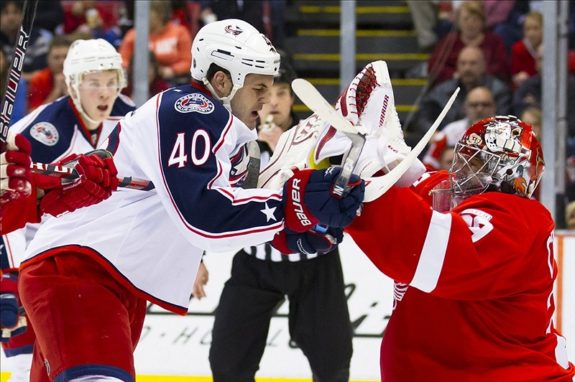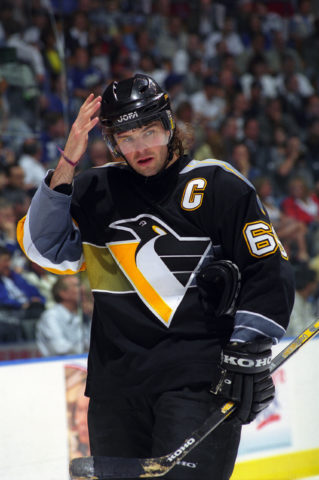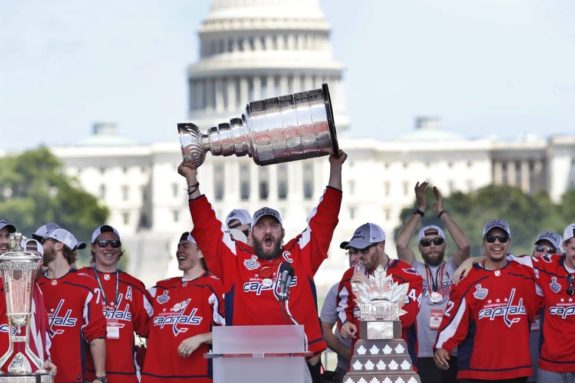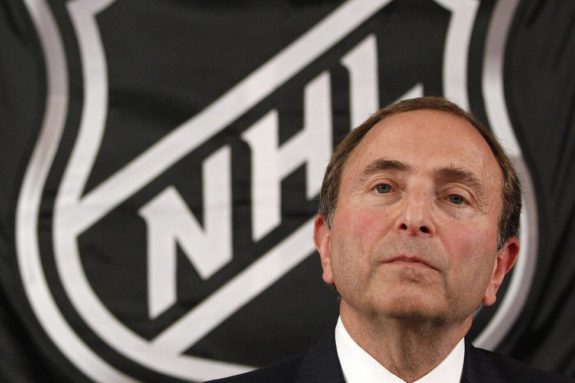With nothing to discuss in the NHL world, outside of labor tension between the league and the NHLPA (which might be the only normal thing to happen in 2020), I thought I’d share my season alignment proposal before the league decides to do something even more ridiculous than what I’m putting forward.
I first brought up my proposal (all of which I have wrote down on pen and paper with a backup file on the Notes app on my phone) on The Hockey Writers Grind Line last Friday, which you should like and subscribe to if you haven’t already. In the last episode, I mentioned that there should be a “Ty Conklin Division”, which is just an appetizer to what I have in store. Today, I’m going to go over my proposed divisions, the teams in each respective division, how many games should be played, and how I’d do the postseason. Get ready, because you’re going to go on a journey you didn’t expect.
The Michel Petit Division
Teams: Vancouver Canucks, Edmonton Oilers, Calgary Flames, Winnipeg Jets, Toronto Maple Leafs, Ottawa Senators, and Montreal Canadiens
This is the highly anticipated all-Canadian division that everyone north of the 49th parallel has been expecting. It’s named after former Canucks first-round pick Michel Petit, who played for five different Canadian teams in his career (Vancouver, Quebec, Toronto, Calgary, and Edmonton). Other names to consider would be Fred Sasakamoose (one of the first Indigenous Canadians in NHL history who passed away recently), or Hayley Wickenheiser (widely considered the greatest female hockey player of all-time). Lot of name options for the potential Canadian Division.
The Rob Blake Division
Teams: Los Angeles Kings, Anaheim Ducks, San Jose Sharks, Vegas Golden Knights, Arizona Coyotes, and Colorado Avalanche
This would be your Pacific/Western Division. It includes the three California teams, the two franchises based in the desert, and at the very least, a geographic rival in the Colorado Avalanche. This might be the most lopsided division as it features two of the biggest Western Conference powerhouses with Vegas and Colorado, but it also could provide some of the biggest fireworks.
I named this division after current Kings GM Rob Blake, who played for LA, Colorado, and San Jose in his career so he fits perfectly. I would also consider calling this the “Wayne Gretzky Division” since Gretzky helped grow hockey in the Southwest US when he joined the Kings in 1988.
The Ty Conklin Division
Teams: Minnesota Wild, St. Louis Blues, Chicago Blackhawks, Detroit, Columbus Blue Jackets, and Buffalo Sabres

Now, you could switch the Sabres for the Pittsburgh Penguins (who Conklin also played for), but I’m saving Pittsburgh for later. Conklin played for the Red Wings, Blue Jackets, Sabres, and Blues in his career, all of which can be used if you want to bother your friends with useless trivia. This is the 2020 version of the Norris Division, with less physicality probably, as most teams are located near the Great Lakes or in the Midwest. There are no other name considerations because it has to be called the Ty Conklin division. No other former player would do it justice.
The Rich Peverley Division
Teams: Dallas Stars, Nashville Predators, Carolina Hurricanes, Washington Capitals, Tampa Bay Lightning, and Florida Panthers
This would be the NHL’s Southern Division from a geographical perspective and I called it the Rich Peverley division because he played for Nashville, Dallas, and Atlanta (as well as the Bruins but that doesn’t matter here) in his career. I can’t think of a significant Rich Peverley moment off the top of my head (no offense Rich) so this division’s name is up for discussion.
But then there’s this:
If the owners are short $300 million, maybe we just get a corporation to sponsor the division? I believe it would be the first time since 1973 that two teams who competed in the Stanley Cup the year before would be in the same division the next season should the Stars and Lightning be paired.
The Jaromir Jagr Division
Teams: Boston Bruins, Pittsburgh Penguins, New Jersey Devils, New York Rangers, New York Islanders, Philadelphia Flyers
Jagr suited up for five of the six teams in this proposed division, missing out on an Islanders stint to cement his legacy among this group of teams. This has the potential to be one of the best divisions in the NHL should they decide to go with these teams as I would argue every team (outside of the Devils) has a chance at winning it.

This might be one of the best divisions in terms of travel as the longest trip would be Pittsburgh to Boston and vice versa.
Regular Season Length
Since the Canadian Division is the only one that features seven teams, they’ll play eight games among each other for a total of 48 games per team. Each team will get four home and road games against every team and while I’m not sure we’ll see the same road trips that we’re used to (ie; back to back in Edmonton and Calgary, rest day, game in Vancouver), there’s plenty of options given the shorter amount of games to play.
- Michel Petit/Canadian Division: 8 games X 6 opponents (4 home, 4 away): 48 games
For the American teams, each team will play eight games against one another for a total of 40 games. Similarly to the Canadian Division, teams will play four home and away games against divisional opponents. In case you’re wondering, yes, I am aware that it would put the American teams eight games behind the Canadian teams. I have created a plan to solve that issue.
- American Divisions: 8 games X 5 opponents (4 home, 4 away); 40 games
After the 40 games played by American teams are complete, we now go to a play-in tournament for playoff positioning. Teams will now shift to a bubble or hub city that will be selected by the top team in each division for their positioning tournament and every remaining divisional game takes place at the chosen venue. For example, the Stars could choose AT&T Stadium in Arlington, Texas, or the Capitals could select the National Mall. Heck, even the Canucks could say they want to play at BC Place for an “outdoor experience”.

In these bubbles or hubs, teams will play five more games against each other for a total of 45 games. After 45 games have been played, the NHL will conduct a draw FIFA style for each division as to each team’s next three opponents in their division so they can the reach the 48-game threshold that the Canadian division has. Of course, in this draw, if a team is selected with their next three opponents already decided, they’ll be replaced by a team who hasn’t reached their three opponents.
- American Divisions: 1 game vs. 5 opponents in Divisional Hub City: total of 45 games
- American Divisions: 1 game vs. 3 opponents decided via draw in Divisional Hub City: total of 48 games
The New and Improved NHL Postseason Format
After every team has reached 48 games played, we’ll now begin a brand new postseason format that will be beneficial to everyone. After we had a 24-team postseason last season, my new playoff format will see 30 teams making the playoffs, which one shameful team not making it past the regular season. Seeds will be decided based on regular season points and division/conference affiliation does not matter. It is the top 30 teams, in whatever order, that are seeded and make the playoffs.
The top two teams get byes in the first round. The remaining teams will play best of five matchups with the highest seeded teams playing the lowest seeded teams. For example:
#3 seed vs. #30 seed
#4 seed vs. #29 seed
#5 seed vs. #28 seed, etc..
Having a longer postseason with more teams would help A) increase lost revenue since the NHL typically makes more during the postseason than the regular season and B) would create more fan intrigue considering their team would most likely be in the postseason. After the first round concludes, teams are reseeded to keep with the highest versus lowest standard we set earlier.
Every round after will be a best of seven series, regardless of conference and division, as it sets up for potentially having the statistically two best teams match up in the Stanley Cup Final. If this postseason method is successful, I propose we continue using it in future seasons. However, there is one potential drawback to this plan that needs to be taken into consideration.
The Big Hurdle with the Plan
The substantial hurdle involved in this plan is the Canadian border and whether Canadian teams can travel. Similar to the regular season, I prefer seeing games take place in a bubble or hub atmosphere but it doesn’t matter to me. The Canadian Division was created to avoid any issues for the regular season but the postseason will be significant for several reasons.

The last time the NHL had to schedule a shortened season was due to the lockout in 2012-13. They scheduled a 48 game regular season like I have and didn’t begin playoffs until April 30th. If we’re aimed for the same timeline in 2021, we have to hope that the border (and international travel) are back to normal in some capacity. Sound COVID-19 numbers and a proper vaccine will be critical to seeing Canadian teams in the postseason.
Otherwise, we could see NHL teams follow the NBA’s Toronto Raptors, who are starting the season in Tampa, Florida. It would be easier to potentially relocate seven Canadian teams to the US compared to 24 American teams to Canada like we saw last season. Although, don’t be surprised if we see Canadian hub cities and bubbles as a potential option again for the 2021 NHL Playoffs.
Finalizing a Plan
Any plan for next season needs to get finalized soon so we can get at least some version of an NHL season. If not, we could be missing out on another year of NHL hockey while the rest of us are desperate to fil our hockey craving. If you like my plan, or absolutely hated, let me know because I’d love to hear your thoughts!